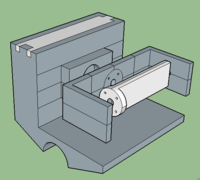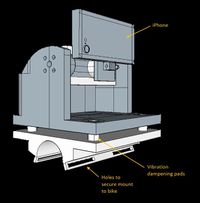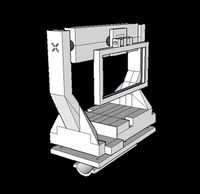Difference between revisions of "Searching for Stability"
Natalie.ng (talk | contribs) |
Natalie.ng (talk | contribs) |
||
| Line 70: | Line 70: | ||
2. '''Motor Control Circuit 1''': After bringing our torque dilemma to Humberto's attention, he told us that there was no way our circuit should have been working, as the Arduino was not providing anywhere near the current or voltage we thought it was due to current-limiting. He suggested a completely new motor control circuit including 6 MOSFET transistors as the answer to our torque problems. Despite being warned to watch our connections as we would now be dealing with large amounts of power, we promptly fried our Arduino. Following Professor Gonzalez's roughly drawn schematic, we built the new circuit and again, managed to get a response from our motors, this time using batteries as an external power supply. For the first time, we were able to generate enough torque to spin our phone. | 2. '''Motor Control Circuit 1''': After bringing our torque dilemma to Humberto's attention, he told us that there was no way our circuit should have been working, as the Arduino was not providing anywhere near the current or voltage we thought it was due to current-limiting. He suggested a completely new motor control circuit including 6 MOSFET transistors as the answer to our torque problems. Despite being warned to watch our connections as we would now be dealing with large amounts of power, we promptly fried our Arduino. Following Professor Gonzalez's roughly drawn schematic, we built the new circuit and again, managed to get a response from our motors, this time using batteries as an external power supply. For the first time, we were able to generate enough torque to spin our phone. | ||
| − | [[File:TransistorCircuit1.JPG|200px]] ===> [[File:SpinningPhone.gif| | + | [[File:TransistorCircuit1.JPG|200px]] ===> [[File:SpinningPhone.gif|150px]] |
3. '''Motor Control Circuit 2''': Though we thought we had been successful, our batteries began to die as the circuit rapidly discharged them. We realized we would need a power supply for the demo, and this is where everything became massively unreliable. Using a power supply, we would get motor control at times and minutes later the motor would be unresponsive to the same code with the same power supply settings. Additionally, a couple of our transistors were getting dangerously hot. Deko suggested that we buy 6 10 ohm, 10 watt resistors in order to get more power to our motors and to prevent our transistors from heating up. While this improvement helped with the heat issue, our reliability issues persisted. | 3. '''Motor Control Circuit 2''': Though we thought we had been successful, our batteries began to die as the circuit rapidly discharged them. We realized we would need a power supply for the demo, and this is where everything became massively unreliable. Using a power supply, we would get motor control at times and minutes later the motor would be unresponsive to the same code with the same power supply settings. Additionally, a couple of our transistors were getting dangerously hot. Deko suggested that we buy 6 10 ohm, 10 watt resistors in order to get more power to our motors and to prevent our transistors from heating up. While this improvement helped with the heat issue, our reliability issues persisted. | ||
| − | [[File:Updated.JPG|200px]] ===> [[File:IMG_5223.TRIM.gif|150px]] + [[File:Ezgif.com-rotate_(1).gif| | + | [[File:Updated.JPG|200px]] ===> [[File:IMG_5223.TRIM.gif|150px]] + [[File:Ezgif.com-rotate_(1).gif|150px]] |
//Check the functionality of both MOSFET Transistors and Diodes// | //Check the functionality of both MOSFET Transistors and Diodes// | ||
Revision as of 05:45, 2 May 2016
Contents
Proposal
Project Description
Overview
Our project is to create a bike-mounted stabilizing platform for iPhone cinematography. We will use the readings from two magnetic encoders to control two motors responsible for stabilizing the platform. Vibration dampening pads in the mounting device itself will provide additional stability. If successful, applications of an inexpensive, compact stabilizing device could be innumerable, from handheld usage to RC and aerial filming and photography.
The mounting device of the gimbal is an original design drafted in SketchUp and produced in AutoCAD.
By the end of the semester we will be able to present iPhone footage from our device to illustrate its stabilizing capabilities.
Team Members
- Natalie Ng
- Nathan Schmetter
- Deko Ricketts (TA)
Objectives
- Program an Arduino module to receive data from magnetic rotary encoders to consistently level the iPhone while in use
- Design and construct a practical and functional mounting device for an iPhone on a bike
- Design and embed the gimbal and additional stability elements either onto or within the mounting platform itself
- Successfully stabilize the iPhone while recording a video from a moving bike
Challenges
- Perfecting the programming of the Arduino module in order to analyze the input from the two magnetic rotary encoders and communicate with the two brushless motors to re-level the iPhone
- Ensuring that input from the encoders is readable to the Arduino
- Identifying appropriate motors to carry out the stabilization of the platform
- Designing the mounting device and modifying gimbal design using 3D printer
- Finding the most effective dampening cushions considering size and weight of platform
- Compacting all elements of the design to create an unobtrusive stabilizing device
Budget
Arduino
- Parts Ordered Online
- Hardware
- 4 9V batteries ($21.99)
- 4 Screws to secure dampening pads
- 3 9V Battery Snap Connectors
- Wire
Total: $90.99
Gantt Chart
Design & Solutions
Modules
Motor Circuit
We began our journey with 3-phase induction motors knowing little else than that they were the best possible motors for generating smooth corrections such as those executed by a gimbal.
1. Direct connection: Our first motor circuit was simple, consisting of the three-phase motor and three wires that fed directly into the Arduino with our laptop as the only power source. Somehow, we managed to make this work without frying anything... Using this circuit we managed to not only get extremely reliable motor control, but also responsive communication between our encoders and our motors. The only catch was that our motors lacked torque.
===>

2. Motor Control Circuit 1: After bringing our torque dilemma to Humberto's attention, he told us that there was no way our circuit should have been working, as the Arduino was not providing anywhere near the current or voltage we thought it was due to current-limiting. He suggested a completely new motor control circuit including 6 MOSFET transistors as the answer to our torque problems. Despite being warned to watch our connections as we would now be dealing with large amounts of power, we promptly fried our Arduino. Following Professor Gonzalez's roughly drawn schematic, we built the new circuit and again, managed to get a response from our motors, this time using batteries as an external power supply. For the first time, we were able to generate enough torque to spin our phone.
===>

3. Motor Control Circuit 2: Though we thought we had been successful, our batteries began to die as the circuit rapidly discharged them. We realized we would need a power supply for the demo, and this is where everything became massively unreliable. Using a power supply, we would get motor control at times and minutes later the motor would be unresponsive to the same code with the same power supply settings. Additionally, a couple of our transistors were getting dangerously hot. Deko suggested that we buy 6 10 ohm, 10 watt resistors in order to get more power to our motors and to prevent our transistors from heating up. While this improvement helped with the heat issue, our reliability issues persisted.
===>
+

//Check the functionality of both MOSFET Transistors and Diodes//
3D Design and Printing
When you compare our first design (below, far left) to our last design (below, far right) of the stabilization platform/gimbal many of the differences are very obvious. However to get from our first design to the final design there were many small steps and changes that each occurred with their own purpose often to solve a specific issue discovered after analyzing the print of the previous prototype. The first design (below, far left) was simply a starting point. It lacked balance, did not even have a mounting bracket for the phone case and was never printer. It did, however, help us realize that we needed a place to place the vibration dampening pads that would smooth out the video. Our second design (below, second to the left), included space for the vibration dampening pads as well as a place to mount the phone, however, with this design, we realized that mounting the phone with such a high center of gravity would be detrimental to the stability of the platform. Our third design (below, second to the right), was actually the first model that we actually printed. It did not take us long to realize that we still needed to think through clearances more due to the fact that when we rotated both the paddle and the phone at the same time the phone ran into one of the upright supports. Since this was the first model that we physically printed, it was the first time we were able to assemble the entire prototype, including the motors and the phone. Upon doing this, we learned that both the paddle and the phone mount were unbalanced and thus the motors could not produce enough torque to rotate them. The process of balancing the paddle and the phone mount took place before printing our fourth and final prototype (below, far right) and is described in more depth below. The final prototype (below, far right), utilized the bike mounting device and the vibration dampening base developed with the third design and once some final balancing was done on the paddle, worked great. Both the paddle and the phone could turn freely within the uprights and we had even added a housing for the encoder that would provide feedback on the rotated position of the paddle.
As previously mentioned, a big step that occurred between the design of our third and fourth prototypes was balancing both the phone and the paddle. Of the two of these, balancing the phone was relatively easy. We modified the original phone mount (below, left) and elongated it so that, when mounted, the phone's center of gravity would line up directly with its axis of rotation.
How-To Detect and Eliminate Internal Edges in 3D Files Before Printing
Coding
Interrupts on Arduino





